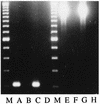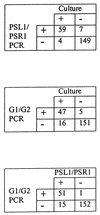Comparison of culture and PCR for detection of Burkholderia cepacia in sputum samples of patients with cystic fibrosis
- PMID: 9620393
- PMCID: PMC104893
- DOI: 10.1128/JCM.36.6.1642-1645.1998
Comparison of culture and PCR for detection of Burkholderia cepacia in sputum samples of patients with cystic fibrosis
Abstract
We investigated the utility of PCR to detect Burkholderia cepacia directly in sputum samples at two cystic fibrosis (CF) centers serving children and adults. Following liquefaction of the sputa by using N-acetyl-L-cysteine, DNA was isolated and analyzed by PCRs with three different primer pairs directed toward bacterial rRNA loci. Two primer pairs were putatively specific for B. cepacia. The other pair, which universally amplifies a band from all bacteria, served as a control. Sputum samples were obtained from 219 patients and analyzed independently by culture and by PCR to detect B. cepacia. The analyses were performed blinded with respect to each other. The results of the PCR with sputa demonstrated that the primers directed to the 16S loci demonstrated approximately 95% concordance with culture results and were more specific than those amplifying the 16S to 23S spacer region. In addition, the 16S primer pair putatively identified B. cepacia in seven patients whose sputa were culture negative at this time. Of these culture-negative patients, five had sputum samples that were culture positive for B. cepacia either prior or subsequent to this study. The results of this study indicate the utility of PCR as a diagnostic method for the rapid identification of B. cepacia in sputum samples of CF patients. We anticipate that improvements in our taxonomic understanding may allow the design of more specific primers for detection of each species of the B. cepacia complex in sputum samples.
Figures


Similar articles
-
PCR-based detection and identification of Burkholderia cepacia complex pathogens in sputum from cystic fibrosis patients.J Clin Microbiol. 2001 Dec;39(12):4247-55. doi: 10.1128/JCM.39.12.4247-4255.2001. J Clin Microbiol. 2001. PMID: 11724828 Free PMC article.
-
Improved molecular detection of Burkholderia cepacia genomovar III and Burkholderia multivorans directly from sputum of patients with cystic fibrosis.J Microbiol Methods. 2002 Apr;49(2):183-91. doi: 10.1016/s0167-7012(01)00367-0. J Microbiol Methods. 2002. PMID: 11830304
-
Identification of Pseudomonas aeruginosa, Burkholderia cepacia complex, and Stenotrophomonas maltophilia in respiratory samples from cystic fibrosis patients using multiplex PCR.Pediatr Pulmonol. 2004 Jun;37(6):537-47. doi: 10.1002/ppul.20016. Pediatr Pulmonol. 2004. PMID: 15114555
-
Burkholderia cepacia complex: a contraindication to lung transplantation in cystic fibrosis?Transpl Infect Dis. 2001 Sep;3(3):149-60. doi: 10.1034/j.1399-3062.2001.003003149.x. Transpl Infect Dis. 2001. PMID: 11493397 Review.
-
Burkholderia Cepacia Complex Causing Pneumonia in an Immunocompetent Non-Cystic Fibrosis Patient: Case Report and Review of Literature.Infect Disord Drug Targets. 2020;20(1):106-110. doi: 10.2174/1871526518666181022112857. Infect Disord Drug Targets. 2020. PMID: 30345929 Review.
Cited by
-
Identification and detection of Stenotrophomonas maltophilia by rRNA-directed PCR.J Clin Microbiol. 2000 Dec;38(12):4305-9. doi: 10.1128/JCM.38.12.4305-4309.2000. J Clin Microbiol. 2000. PMID: 11101555 Free PMC article.
-
Discrimination of Burkholderia multivorans and Burkholderia vietnamiensis from Burkholderia cepacia genomovars I, III, and IV by PCR.J Clin Microbiol. 1999 May;37(5):1335-9. doi: 10.1128/JCM.37.5.1335-1339.1999. J Clin Microbiol. 1999. PMID: 10203482 Free PMC article.
-
Direct PCR assay for detection of Neisseria meningitidis in human cerebrospinal fluid.Folia Microbiol (Praha). 1999;44(6):689-94. doi: 10.1007/BF02825663. Folia Microbiol (Praha). 1999. PMID: 11097028
-
PCR-based detection and identification of Burkholderia cepacia complex pathogens in sputum from cystic fibrosis patients.J Clin Microbiol. 2001 Dec;39(12):4247-55. doi: 10.1128/JCM.39.12.4247-4255.2001. J Clin Microbiol. 2001. PMID: 11724828 Free PMC article.
-
Species-specific PCR as a tool for the identification of Burkholderia gladioli.J Clin Microbiol. 2000 Jan;38(1):282-5. doi: 10.1128/JCM.38.1.282-285.2000. J Clin Microbiol. 2000. PMID: 10618102 Free PMC article.
References
-
- Anonymous. Pseudomonas cepacia—more than a harmless commensal? Lancet. 1992;339:1385–1386. - PubMed
-
- Campbell P W, III, Phillips III J A, Heidecker G J, Krishnamani M R S, Zahorchak R, Stull T L. Detection of Pseudomonas (Burkholderia) cepacia using PCR. Pediatr Pulmonol. 1995;20:44–49. - PubMed
-
- Deneer H G, Knight I. Inhibition of the polymerase chain reaction by mucolytic agents. Clin Chem. 1994;40:171–172. - PubMed
Publication types
MeSH terms
Substances
LinkOut - more resources
Full Text Sources
Medical

